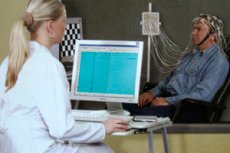Medical expert of the article
New publications
Visual evoked potentials
Last reviewed: 07.07.2025

All iLive content is medically reviewed or fact checked to ensure as much factual accuracy as possible.
We have strict sourcing guidelines and only link to reputable media sites, academic research institutions and, whenever possible, medically peer reviewed studies. Note that the numbers in parentheses ([1], [2], etc.) are clickable links to these studies.
If you feel that any of our content is inaccurate, out-of-date, or otherwise questionable, please select it and press Ctrl + Enter.

Visual evoked potentials (VEP) are recorded to diagnose damage to the visual pathways, assessing their condition from the peripheral (retina) to the central sections (primary and secondary visual centers). The method of recording visual evoked potentials to a flash of light and a reversible pattern is widely used in the clinic to diagnose diseases of the visual pathways and pathology of the optic nerve, with edema, inflammation, atrophy, compression injuries of traumatic and tumor genesis, localization of the pathological process in the chiasm, optic tract and cerebral cortex, amblyopia and retinal diseases.
Visual evoked potentials reflect mainly the electrical activity of the macular region, which is associated with its abundant representation in the calcarine sulcus compared to the periphery. Diffuse flashes of light and spatially structured stimuli in the form of checkerboard patterns and grids with a rectangular illumination profile are usually used as stimuli. The types of visual evoked potentials depend on the nature of the stimulus: a visual evoked potential to a flash of light is called a flash potential, to a pattern stimulus - a pattern VEP. When recording this form of visual evoked potentials, stimuli are presented either in the on-off mode, when the average illumination of the pattern and the homogeneous field replacing it is constant, or in the reversal mode, when in the image of a checkerboard field constantly present on the monitor screen, white squares are replaced by black ones, and black ones by white ones. Visual evoked potentials to a flash allow one to obtain approximate information about the state of the optic nerve and the visual pathway above the chiasm.
Visual evoked potentials complement the results of electroretinography and are the only source of information about the visual system in cases where ERG cannot be recorded for one reason or another.
The criteria for clinically significant deviations in the assessment of visual evoked potentials are the absence of a response or a significant decrease in amplitude, prolongation of the latency of all peaks, significant differences in amplitude and latency during stimulation of the right and left. In newborns or uncooperative patients, normal visual evoked potentials do not yet prove the presence of consciousness and perception of visual images, but can only indicate the preservation of light sensitivity.
Fluorescent angiography, ultrasound examinations, scanning laser ophthalmoscopy, and optical coherence tomography also play an important role in the differential diagnosis of diseases of the retina and choroid.
What do need to examine?
How to examine?

